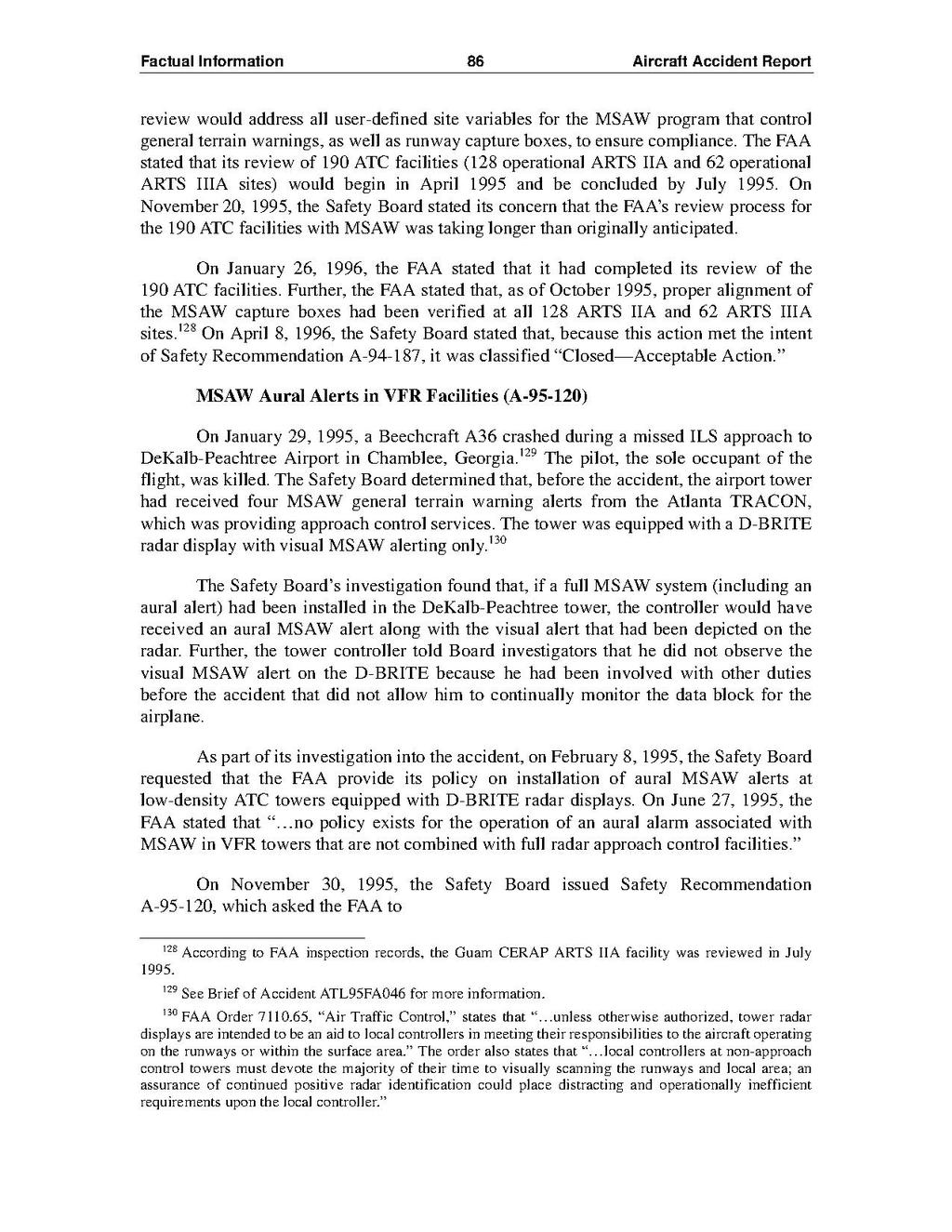review would address all user-defined site variables for the MSAW program that control general terrain warnings, as well as runway capture boxes, to ensure compliance. The FAA stated that its review of 190 ATC facilities (128 operational ARTS IIA and 62 operational ARTS IIIA sites) would begin in April 1995 and be concluded by July 1995. On November 20, 1995, the Safety Board stated its concern that the FAA's review process for the 190 ATC facilities with MSAW was taking longer than originally anticipated.
On January 26, 1996, the FAA stated that it had completed its review of the 190 ATC facilities. Further, the FAA stated that, as of October 1995, proper alignment of the MSAW capture boxes had been verified at all 128 ARTS IIA and 62 ARTS IIIA sites.[1] On April 8, 1996, the Safety Board stated that, because this action met the intent of Safety Recommendation A-94-187, it was classified "Closed--Acceptable Action."
MSAW Aural Alerts in VFR Facilities (A-95-120)
On January 29, 1995, a Beechcraft A36 crashed during a missed ILS approach to DeKalb-Peachtree Airport in Chamblee, Georgia.[2] The pilot, the sole occupant of the flight, was killed. The Safety Board determined that, before the accident, the airport tower had received four MSAW general terrain warning alerts from the Atlanta TRACON, which was providing approach control services. The tower was equipped with a D-BRITE radar display with visual MSAW alerting only.[3]
The Safety Board's investigation found that, if a full MSAW system (including an aural alert) had been installed in the DeKalb-Peachtree tower, the controller would have received an aural MSAW alert along with the visual alert that had been depicted on the radar. Further, the tower controller told Board investigators that he did not observe the visual MSAW alert on the D-BRITE because he had been involved with other duties before the accident that did not allow him to continually monitor the data block for the airplane.
As part of its investigation into the accident, on February 8, 1995, the Safety Board requested that the FAA provide its policy on installation of aural MSAW alerts at low-density ATC towers equipped with D-BRITE radar displays. On June 27, 1995, the FAA stated that "...no policy exists for the operation of an aural alarm associated with MSAW in VFR towers that are not combined with full radar approach control facilities."
On November 30, 1995, the Safety Board issued Safety Recommendation A-95-120, which asked the FAA to
- ↑ According to FAA inspection records, the Guam CERAP ARTS IIA facility was reviewed in July 1995.
- ↑ See Brief of Accident ATL95FA046 for more information.
- ↑ FAA Order 7110.65, "Air Traffic Control," states that "...unless otherwise authorized, tower radar displays are intended to be an aid to local controllers in meeting their responsibilities to the aircraft operating on the runways or within the surface area." The order also states that "...local controllers at non-approach control towers must devote the majority of their time to visually scanning the runways and local area; an assurance of continued positive radar identification could place distracting and operationally inefficient requirements upon the local controller."
